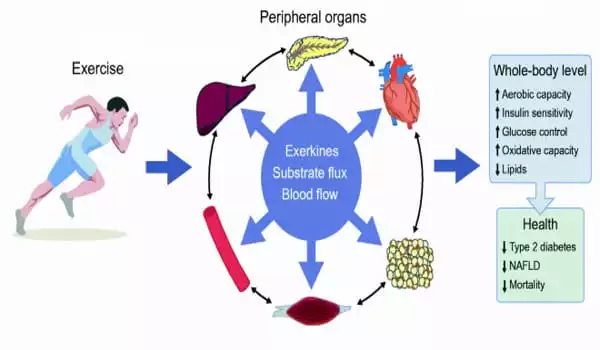Exercise is a critical step in achieving your aim of managing type 2 diabetes or preventing it entirely. According to a new study from the University of Eastern Finland, regular physical activity dramatically modifies the body’s metabolite profile, and many of these changes are related to a lower risk of type 2 diabetes. More than 7,000 males were included in the study and were followed up for eight years. Men in the highest physical activity category had a 39% reduced risk of type 2 diabetes than men in the lowest physical activity category.
Physical activity was linked to the levels of 198 metabolites, or substances created as a function of the body’s metabolism, and increasing physical activity was linked to some of the same metabolites previously linked to a health-promoting diet. Furthermore, the study found that increasing physical activity boosts insulin secretion.
Fasting glucose samples from research participants yielded a total of 1,260 metabolites. The relationship between physical activity and metabolite profile has never been explored in such depth or with such a large cohort. Indeed, this study, published in Metabolites, is the first to reveal a link between numerous metabolites and physical activity.
The researchers looked at the relationship between physical activity and metabolite profile, insulin sensitivity, insulin secretion, and the risk of type 2 diabetes in men who took part in the METabolic Syndrome in Men (METSIM) trial.
The researchers looked at the relationship between physical activity and metabolite profile, insulin sensitivity, insulin secretion, and the risk of type 2 diabetes in men who took part in the METabolic Syndrome in Men (METSIM) trial. At the start of the trial, none of the patients had diabetes. Participants completed a physical activity questionnaire at the start of the trial and again eight years later, and they also had an oral glucose tolerance test and their metabolites from a fasting glucose sample analyzed.
Men were divided into four groups based on their level of physical activity: those who were physically inactive, those who were physically active only occasionally, those who were physically active regularly but no more than twice a week, and those who were physically active at least three times a week. A single session of physical activity was defined as lasting at least 30 minutes.
Physical exercise was linked to the levels of 198 different metabolites. Physical exercise, among other things, altered the levels of numerous lipids in a way that has previously been linked to a lower risk of type 2 diabetes in prior studies. Previous research has found that a health-promoting diet has some similar relationships with unsaturated fatty acid levels, for example. Steroids, amino acids, imidazoles, carboxylic acids, and hydroxy acids were found as completely new metabolic biomarkers connected with physical exercise by the researchers.

When compared to males who were physically inactive, the risk of acquiring type 2 diabetes was 39 percent lower for men who were physically the most active, and 30 percent lower even for individuals who were physically active no more than twice a week. Men who increased their physical activity during the follow-up had lower fasting glucose and insulin levels, as well as improved insulin sensitivity and secretion.
Exercise for insulin health, fortunately, does not have to be difficult. The standards for exercising with diabetes are nearly identical to the federal guidelines for all individuals, regardless of blood sugar status. Adults with type 2 diabetes should engage in at least 150 minutes of moderate- to vigorous-intensity physical exercise every week, according to the American Diabetes Association. Weekly exercise should ideally be spread out over at least three days, with no more than two days going by without some form of activity. For those engaging in high-intensity exercise, shorter durations of 75 minutes per week may be sufficient.
Importantly, resistance or strength training should be included in at least two or three weekly exercises, preferably on nonconsecutive days. According to Nick Occhipinti, CSCS, an exercise physiologist located in Red Bank, New Jersey, completing both aerobic (also known as cardiovascular) exercise and strength training is considerably more beneficial at boosting insulin health than either type of exercise alone.
Despite multiple investigations, the relationship between physical activity and insulin secretion has remained unknown. The new study confirms that increasing physical exercise enhances insulin secretion.















